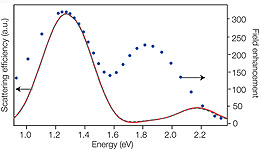Research Abstract
ギャップモード多重極プラズモン場のナノスケール干渉パターン
Nanoscale interference patterns of gap-mode multipolar plasmonic fields
2012年10月24日 Scientific Reports 2 : 764 doi: 10.1038/srep00764

光の電場の任意の空間分布は、適切な振幅と位相を持つ個々の波数モード場の干渉を通して形成されるが、遠方場における最大波数は光の波長によって制限される。対照的に、局在表面プラズモン(LSP)には、回折限界を超えるナノメートルスケールの領域に光子を強く閉じ込める能力がある。特に、ギャップモードLSPは、ホットスポットと呼ばれる数ナノメートル程度のきわめて高強度の局在場を作る。今回我々は、ホットスポット内部におけるLSP場のナノスケール空間プロファイルが、単一のピークではなく、複雑な微細構造を示すことを明らかにした。このナノパターンは、双極子や四重極子、さらに高次の多重極プラズモンモードの強め合いや弱め合いの干渉によって生成され、励起光学系のパラメーターを制御することで、パターンを劇的に変化させることができる。本解析は、ナノ空間における光と物質の相互作用を操作し制御する新しい概念の提案に役立つ可能性がある。
田中 嘉人1, 真田 彬央1 & 笹木 敬司1
- 北海道大学 電子科学研究所 光システム計測研究室
Arbitrary spatial distributions of the electric field of light are formed through the interference of individual wavenumber mode fields with appropriate amplitudes and phases, while the maximum wavenumber in the far field is limited by the wavelength of light. In contrast, localized surface plasmons (LSPs) possess the ability to confine photons strongly into nanometer-scale areas, exceeding the diffraction limit. In particular, gap-mode LSPs produce single-nanometer-sized, highly intense localized fields, known as hot spots. Here, we show the nanoscale spatial profiles of the LSP fields within hot spots, which exhibit complicated fine structures, rather than single peaks. The nanopatterns are created by constructive and destructive interferences of dipolar, quadrupolar, and higher-order multipolar plasmonic modes, which can be drastically altered by controlling parameters of the excitation optical system. The analysis in this study would be useful for proposing new concepts for manipulation and control of light-matter interactions in nanospaces.

